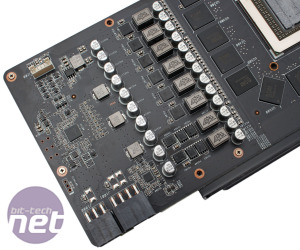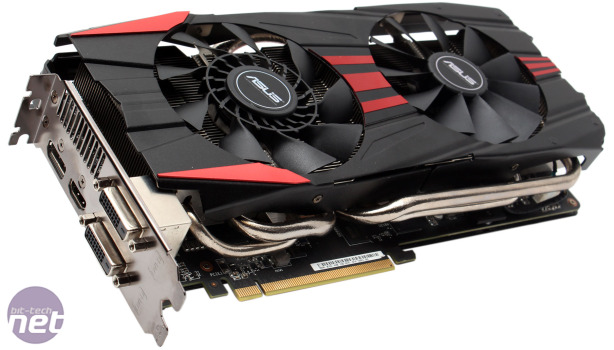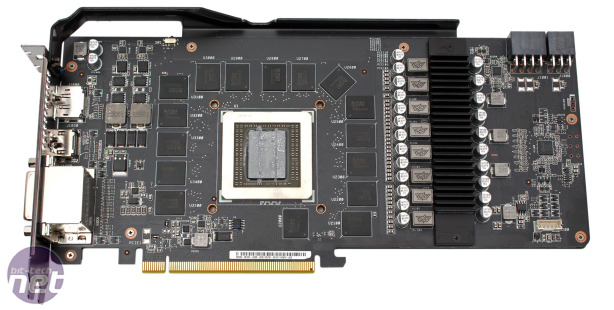ASUS Radeon R9 290 DirectCU II OC Review
Manufacturer: ASUSUK price (as reviewed): £340.81 (inc VAT)
US price (as reviewed): $549.99 (ex Tax)
At launch, the R9 290 was well positioned on the price-performance scale, but it was let down by a basic and poor quality stock cooler that resulted in high temperatures and even higher noise output. Thankfully, custom cooled cards are now here in numbers, and we've got Asus's version of the R9 290 which has been given the DirectCU II cooler treatment as well as a factory overclock and some hardware upgrades too. It's £340 at the time of writing, which gives it a £40 premium over the standard R9 290 cards and leaves it £20 cheaper than the cheapest GTX 780 though most of these, like the R9 290X, are closer to £400.
To recall, the R9 290 uses AMD's Hawaii GPU with four Compute Units disabled. Compared to the R9 290X, it thus features reduced counts of stream processors (2,560) and texture units (160) but maintains the full set of 64 ROPs and the 512-bit memory bus paired with 4GB of GDDR5. Usually, it's clocked at 947MHz, which represents the highest frequency the card will run at if it can do so while staying within its power, fan and thermal limits. Asus, however, has pushed the clock speed by a modest 6 percent to 1,000MHz, the same as the R9 290X. Oddly, it has also bumped the memory frequency by a ridiculously tiny amount, taking it from 1.25GHz to 1.26GHz (5.04GHz effective), for a memory bandwidth of 322.56GB/sec.
As a result of the DirectCU II cooler, the card is longer than usual at 287mm and also taller than a standard PCI bracket. On the front face is a cool black and red metal shroud which leaves the heatsink exposed and will thus result in hot air being expelled into your case – good case ventilation is a must. Round the back is a lovely brushed metal backplate that's used for stability rather than cooling, and will also look better than a bare PCB through a window.
The 6-pin and 8-pin power connections have red and green LEDs beneath them so you can easily see whether they're correctly wired. Meanwhile the I/O panel sports the standard selection of outputs, and there's no support for older VGA panels thanks to the use of DVI-D ports only. As usual, there's no CrossFire connectors as the need for these has been eliminated in Hawaii cards.
For this card, Asus has made use of the dual BIOS switch on the PCB, which AMD did not in its reference model. It's positioned on the PCB edge near the rear I/O panel and two modes are available: Silent and Performance. The first is the standard R9 290 configuration with a maximum fan speed of 47 percent and a target temperature of 95°C, while the second increases the maximum fan speed to 50 percent and removes the target temperature option from the Catalyst Control Centre. Asus's handy GPU Tweak software allows you to set fan speed manually or create your own temperature-based fan curves.
The DirectCU II cooler comprises two 92mm fans atop a massive heatsink. The fans connect to a single header, so their speed cannot be independently altered, and the left fan features Asus's proprietary CoolTech design, with an inner radial blower section coupled with a standard set of outer flower fans. In case you're not convinced as to the effectiveness of this, Asus has made a handy demonstration video (with a dubstep backing, of course). The heatsink beneath is reassuringly weighty and solid. It sports five nickel-plated copper heat pipes, three of which make direct contact with the GPU. The thickest one loops out at the top of the card, while the remaining four emerge beneath and branch out to either side of the heatsink.


Click to enlarge - The GPU core and memory chips (left) and the 8-phase DIGI+ VRM power components (right)
Prying the cooler off reveals the custom PCB with Elpida W2032BBBG-6A-F memory chips, which are 1.5V models rated for 6Mbps. None are directly cooled by the heatsink but they will receive airflow from the fans. Next to these is Asus's DIGI+ VRM power circuitry, with the controller located at the far right. This is connected to a 6+2 phase layout, meaning the GPU and memory are both served by one more phase each than the reference cards. Power is calculated and delivered digitally and each of the power phase components (capacitors, chokes and MOSFETs) use Super Alloy Power technology, which means they're hardened by a special alloy to reduce noise and improve their efficiency and lifespan. As you can see, the MOSFETs are all directly cooled by a small black heatsink too.
The card is supplied with a standard accessories pack featuring a software CD (drivers and GPU Tweak) alongside a dual 6-pin to single 8-pin PCI-E power adaptor.
Specifications
- Graphics processor AMD Radeon R9 290 4GB, 1,000MHz
- Pipeline 2,560 stream processors, 160 texture units, 64 ROPs
- Memory 4GB GDDR5, 5.04GHz effective
- Bandwidth 322.56GB/sec, 512-bit interface
- Compatibility Direct X 11.2, OpenGL 4.3, Mantle
- Outputs/Inputs 2 x Dual Link DVI-D, HDMI, DisplayPort
- Power connections 1 x 8-pin PCI-E, 1 x 6-pin PCI-E, top-mounted
- Size 287mm long, dual-slot
- Warranty Three years

MSI MPG Velox 100R Chassis Review
October 14 2021 | 15:04













Want to comment? Please log in.